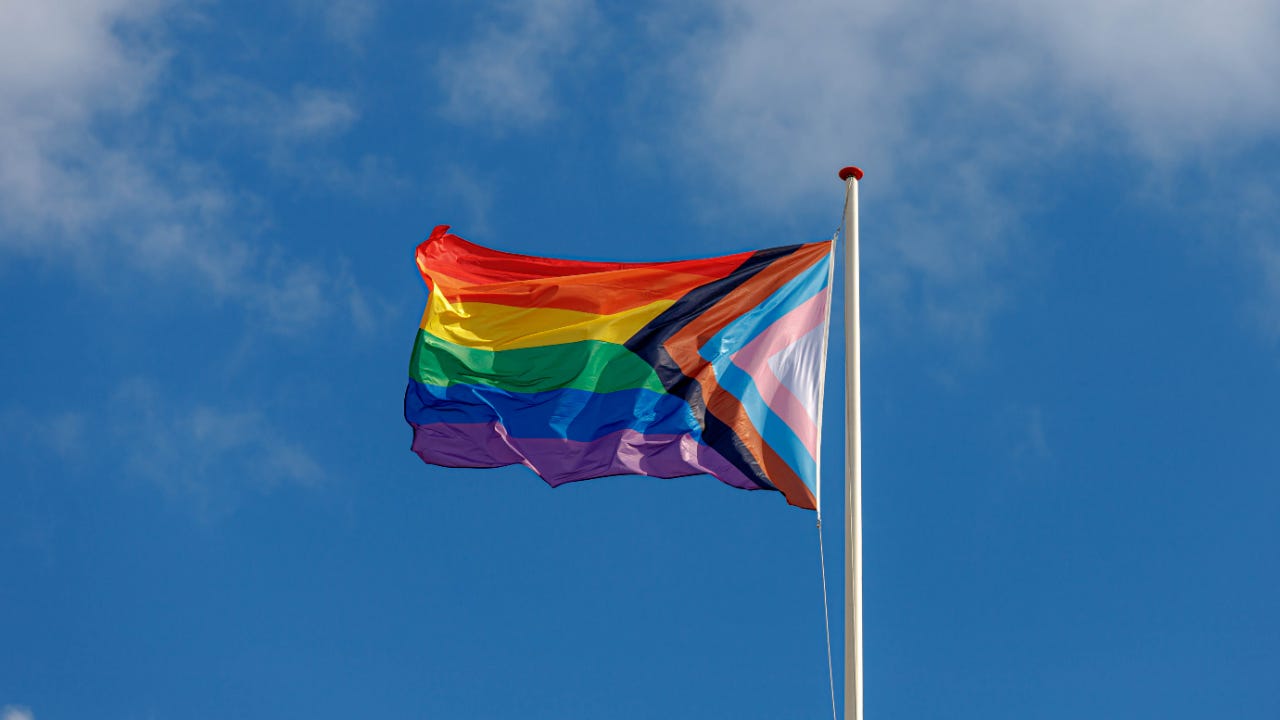LGBTQ+ guide to personal finance 2023

The Bankrate promise
At Bankrate we strive to help you make smarter financial decisions. While we adhere to strict , this post may contain references to products from our partners. Here's an explanation for . The content on this page is accurate as of the posting date; however, some of the offers mentioned may have expired. Terms apply to the offers listed on this page. Any opinions, analyses, reviews or recommendations expressed in this article are those of the author’s alone, and have not been reviewed, approved or otherwise endorsed by any card issuer.
As we celebrate Pride Month, it’s important to recognize the LGBTQ+ community’s successes while also raising awareness for the changes that are still needed.
LGBTQ+ Americans have made great strides toward equality since the 1969 Stonewall Riots that birthed the modern LGBTQ+ rights movement and annual Pride celebrations. But inequities still exist — especially in personal finance.
Studies show that LGBTQ+ adults are, on average, behind other Americans when it comes to retirement savings, debt and other measures of financial well-being. In this guide, we’ll address the financial disparities that exist and highlight resources that can help.
Key LGBTQ+ finance statistics
- 7.2 percent of U.S. adults identify as lesbian, gay, bisexual, transgender or something other than heterosexual (Gallup)
- 17 percent of LGBT people in the U.S. lived in poverty in 2021, compared to 12 percent of non-LGBT people (UCLA)
- Mortgage loan approval rates were 3 to 8 percent lower for same-sex couples than heterosexual couples (Iowa State University)
- 82 percent of LGBTQ+ people surveyed stated they have a credit card in their own name (Bankrate/Suzy)
- 37 percent of LGBTQ+ adults have student loan debt, compared with 21 percent of all adults (Motley Fool/The Debt Guys)
- 37 percent of LGBTQ+ adults have personal loan debt, compared with 6 percent of all adults (Motley Fool/The Debt Guys)
- 52 percent of LGBTQ+ adults have less than $10,000 in savings, compared with 43 percent of all adults (Motley Fool/The Debt Guys)
- 48 percent of LGBTQ+ Americans have experienced discrimination by someone in the financial services, banking or investing industries (Motley Fool/The Debt Guys)
LGBTQ+ financial legislation history
For decades, LGBTQ+ Americans have ridden the societal ups and downs of legislation that affects their finances. Here are some of the highlights and lowlights:
- 1969: The Stonewall Riots at New York City’s Stonewall Inn ushered in the modern movement for LGBTQ+ rights.
- 1974: The federal Equal Credit Opportunity Act passes, prohibiting discrimination tied to credit transactions (such as loan and credit card approvals) based on race, color, religion, national origin, sex, marital status, age or income. However, the law excluded discrimination by sexual orientation and gender identity.
- 1988: Federal lawmakers updated the Fair Housing Act to ban discrimination against buyers or renters based on race, color, national origin, religion, sex and disability. Again, the law didn’t cite discrimination associated with sexual orientation and gender identity.
- 2015: The U.S. Supreme Court legalized same-sex marriage nationwide The ruling allowed same-sex couples the same tax and other financial benefits afford to heterosexual couples.
- 2020: The U.S. Supreme Court ruled that federal law prohibits discrimination against workers based on sexual orientation or gender identity.
- 2021: The U.S. Department of Housing and Urban Development (HUD) added sexual orientation and gender identity to the categories of people covered by enforcement of the Fair Housing Act.
- 2021: The federal Consumer Financial Protection Bureau extended protections under the Equal Credit Opportunity Act to LGBTQ+ Americans, prohibiting discrimination based on sexual orientation and gender identity.
Financial inequities for the LGBTQ+ community
Personal finance isn’t just about income; it touches nearly every aspect of how we live. For instance, LGBTQ+ Americans are, on average, less insured, more in debt and have less in savings.
Given the data points explored below, it’s no wonder that a 2022 survey co-sponsored by Debt Free Guys, an LGBTQ+ financial blog, and The Motley Fool found that two-thirds of LGBTQ+ Americans suffer high financial stress every day.
In particular, some of the top financial concerns of LGBTQ+ adults — as identified by a Bankrate/Suzy survey — include navigating inflation and high costs of living, saving for retirement, low wages and a general lack of money, paying off debt, high healthcare costs and paying taxes.
Income and savings for LGBTQ+ people
The income gap is real for many LGBTQ+ people, and intersectionality often deepens the divide. In some cases, the news is good. Data from the U.S. Census Bureau found that same-sex married couples had a higher median household income ($107,200) compared to opposite-sex married couples ($96,930).
Data from The Motley Fool and Debt Free Guys also sees high earnings for LGBTQ+ Americans, with annual earnings of $100,000 being most commonly reported. However, their survey found that LGBTQ+ are less likely to report this level of earnings than all Americans at large.
| Annual earnings | LGBTQ+ Americans | All Americans |
|---|---|---|
| Source: The Motley Fool and Debt Free Guys April 2022 LGBTQ+ Finances Survey | ||
| $25,000 or less | 14% | 18% |
| $25,001 to $50,000 | 19% | 21% |
| $50,001 to $75,000 | 23% | 17% |
| $75,001 to $100,000 | 18% | 13% |
| $100,000 or more | 26% | 31% |
Other sources report income discrepancies that trend in the opposite direction — particularly in the case of lower-income individuals. For instance, in a survey by Family Equality, 29 percent of all LGBTQ+ respondents reported annual household incomes under $25,000, compared to 22 percent of non-LGBTQ+ respondents.
One factor that may be contributing to these figures is the wage gap experienced by LGBTQ+ workers, who earn about 90 cents for every $1 earned by a typical American worker, according to the HRC Foundation. Individual ethnic and racial minority groups are affected by this wage gap in different ways. Compared to $1 earned by a typical worker:
- An LGBTQ+ Asian/Pacific Islander worker earns $1
- An LGBTQ+ white worker earns 97 cents
- An LGBTQ+ Latinx worker earns 90 cents
- An LGBTQ+ Black worker earns 80 cents
- An LGBTQ+ Native American worker earns 70 cents
Male workers in the LGBTQ+ community earn about 4 percent less than the typical worker, according to the HRC Foundation analysis. For female workers in the LGBTQ+ community, there’s a 13 percent shortfall.
LGBTQ+ individuals also tend to have less in savings. According to the same analysis by the HRC Foundation, a smaller percentage of LGBTQ+ Americans have $10,000 or more in savings than their non-LGBTQ+ counterparts.
“Previous research has found that LGBTQ+ adults in the United States, on average, fare worse economically than their straight and cisgender counterparts,” the HRC Foundation declared in releasing its findings about pay.
Credit cards and debt for LGBTQ+ people
The financial worries of LGBTQ+ Americans are aggravated by the credit card debt that they carry.
The Motley Fool and Debt Free Guys survey found that 56 percent of LGBTQ+ adults have credit card debt, compared with 45 percent of all adults. Further, the median credit card debt for LGBTQ+ Americans stands at $3,000 — 11 percent higher than the average American.
Bankrate’s take: 64 percent of LGBTQ+ adults say a main reason they use credit cards is for rewards.
Keep in mind: Credit card rewards can be offered in cash back, points, miles or other redemption options, depending on the type of card you use.
Money tip: To maximize your rewards earnings, figure out which type of rewards credit card is right for you by analyzing your lifestyle and spending habits
Credit scores for LGBTQ+ people
A smaller percentage of LGBTQ+ Americans have credit in the “very good” to “excellent” ranges.
| Credit score | LGBTQ+ Americans | All Americans |
|---|---|---|
| Source: The Motley Fool and Debt Free Guys April 2022 LGBTQ+ Finances Survey | ||
| 300-579 (fair) | 12% | 16% |
| 580-669 (poor) | 22% | 18% |
| 670-739 (good) | 26% | 21% |
| 740-799 (very good) | 24% | 25% |
| 800-850 (excellent) | 16% | 20% |
| Don’t know | 8% | Unavailable |
Homeownership for LGBTQ+ people
A 2019 study at Iowa State University analyzed national mortgage data from 1990 to 2015 and discovered the approval rate for same-sex couples was 3 to 8 percent lower than the rate for opposite-sex couples. The researchers also found that same-sex applicants were 73 percent more likely than opposite-sex couples to have their mortgage applications rejected, and that same-sex borrowers were hit with higher fees and interest rates than heterosexual couples.
Knowing this, it’s unsurprising that The Motley Fool and Debt Free Guys found that only 26 percent of LGBTQ+ Americans have a mortgage, compared with 40 percent of all Americans.
Retirement for LGBTQ+ people
A huge component of a healthy financial plan is retirement savings. Unfortunately, a study from Transamerica Institute found that LGBTQ+ Americans tend to be less prepared for retirement than non-LGBTQ+ Americans.
According to the study’s data, 67 percent of LGBTQ+ workers are confident of being able to retire comfortably, compared with 71 percent of non-LGBTQ+ workers. Further, 67 percent of LGBTQ+ workers have access to an employer-sponsored 401(k) or similar retirement plan, compared to 73 percent of non-LGBTQ+ workers.
Healthcare and family planning for LGBTQ+ people
LGBTQ+ adults can also face costly barriers to accessing healthcare and family planning services.
In 2019, 12.7 percent of LGBTQ+ individuals did not have health insurance, compared to 11.4 percent of non-LGBTQ+ individuals, per Department of Health and Human Services data. Those who are insured may still have difficulty accessing gender-affirming care, as 26 states and four U.S. territories have no law providing LGBTQ+ inclusive insurance protections among private employers.
Family planning can also represent a major financial burden, as many of the options available to LGBTQ+ people — such as adoption, surrogacy, and IVF — can be very expensive and reach into the tens of thousands of dollars or more. The need to establish while utilizing these family-building methods can also increase LGBTQ families’ costs by $100 to 3,000, according to Family Equality.
New financial frontiers
In any area, the first step toward equality is understanding where disparities exist. Next comes action. With this wealth of data available, financial services firms and nonprofit initiatives are taking action to help close financial gaps for LGBTQ+ adults through specialized products, targeted services and philanthropic efforts. A few examples include:
- Superbia Services’ goal is to wipe out discrimination in the financial services sector, and it aims to offer a credit union, credit cards, life insurance and health insurance focused on LGBTQ+ customers and allies.
- Founded in 2020, Daylight Bank is a digital banking platform for the LGBTQ+ community offering checking accounts, fee-free access to ATMs and financing solutions for family planning. Daylight also allows customers to choose their desired names for accounts and debit cards.
- In 2021, Mastercard expanded its True Name program. True Name enables customers to put their desired name on payment cards. BMO Harris, Citi and Republic Bank are among the brands that have joined the True Name program.
- At the outset of Pride Month in 2022, Family Wealth Management Group introduced its new Rainbow Network for LGBTQ+ financial advisors.
LGBTQ+ financial resources
Finance is personal. Here are a few financial resources, from large institutions that publicly support the LGBTQ+ community to those specifically designed to help LGBTQ+ Americans.
-
- Daylight Bank
- Superbia
- Family Wealth Management Group
- XY Planning
- Christopher Street Financial
- Be Intentional Financial
- David Rae
- Skylight Financial Group
- Treece Financial Group
- Quiet Wealth
-
- Chase
- BMO Harris Bank
- Comerica
- Bank of the West
- Bank of America
- Barclays
- BBVA USA
- Fifth Third
- KeyCorp
- PNC
- Regions
- TD Bank
- Truist
- U.S. Bank
- Wells Fargo
- Navy Federal CU
- Element FCU
- Verity CU
- Redwood CU
- VyStar CU
- Brightstar CU
- Numerica CU
- Green Street CU
- UW CU
- American Eagle Financial CU
-
- Ally Financial
- American Express
- Capital One
- Charles Schwab
- Citi
- Discover
- Edward Jones
- Experian
- Freddie Mac
- Fannie Mae
- Franklin Templeton
- Genworth
- H&R Block
- HSBC
- Invesco
- John Hancock
- LendingClub
- MassMutual
- Mastercard
- Morgan Stanley
- PayPal
- PIMCO
- Prudential
- Principal
- Raymond James
- RBC
- State Street
- Synchrony
- T. Rowe Price
- TransUnion
- USAA
- Vanguard
- Visa
- Voya
-
- For the Gworls
- Point of Pride HRT fund
- Edie Windsor Coding Scholarship
- Next Generation Project
- Ali Forney Center
- Point Foundation
- Human Rights Campaign
- SAGEcents
- Center for Financial Inclusion
- SF LGBT Center
- Compass LGBTQ Community Center
- DC Center for the LGBT Community
- Certified Financial Planner Board of Standards
- Alexander Foundation
- Life Happens
-
The Debt Free Guys blog, run by personal finance experts (and husbands) David Auten and John Schneider, offers a queer take on slashing debt. Their blog, podcast and online tools are aimed at helping “live fabulously, not fabulously broke.”
Financial educator K. Kenneth Davis, known as “The Trans Capitalist,” is determined to boost the financial literacy of LGBTQ+ Americans. Among Davis’ offerings are a step-by-step money guide, financial literacy workshops, one-on-one financial coaching, online investment courses and financial counseling for couples.
SAGE, a nonprofit organization serving older LGBTQ+ Americans, provides a variety of legal and financial resources. Among them is SAGEcents, a digital platform designed to help older LGBTQ+ people improve their financial literacy and stability. The platform’s financial backer is the Wells Fargo Foundation.
The Human Rights Campaign, an LGBTQ+ civil rights group, and the HRC Foundation promote a number of legislative and policy changes aimed at bettering the financial lives (and all-around lives) of LGBTQ+ Americans.
The Oh My Dollar! blog, created by Lillian Karabaic, is “an inclusive, no-judgment place to talk about money for people of all incomes.”
The bottom line
LGBTQ+ Americans have made substantial strides toward financial parity in recent years, but challenges still exist. Supporting financial organizations that are working to resolve these disparities, improving education around the financial challenges impacting LGBTQ+ adults and advocating for stronger financial protections for the LGBTQ+ community can all help to further advance this progress.
Related Articles

LGBTQ+ friendly banking: How to find inclusive banks that support the LGBTQ+ community


